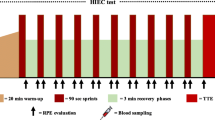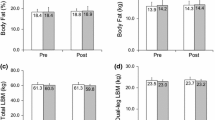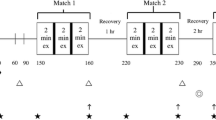Summary
Previous studies have shown that sustained exercise in human subjects causes an increase in the plasma concentration ratio of free tryptophan: other large neutral amino acids [including the branched-chain amino acids (BCAA)]. This should favour the transport of tryptophan into the brain and also the synthesis of 5-hydroxytryptamine, which is thought to contribute to fatigue during prolonged exercise. A mixture of the three BCAA was given to subjects during a 30-km cross-country race or a marathon (42.2 km) and the effects on mental and physical performances were measured. The mental performance, measured as the performance in the Stroop Colour and Word Test (CWT), was improved after, as compared to before the 30-km cross-country race when a BCAA supplement was given during the race, whereas the CWT scores were similar before and after in the placebo group. The running performance in the marathon was improved for the “slower” runners (3.05 h–3.30 h) when BCAA was taken during the race; however, there was no significant effect on the performance in the “faster” runners (<3.05 h). The results showed that both mental and physical performance was improved by an intake of BCAA during exercise. In addition, the effects of exercise on the plasma concentration of the aromatic amino acids were altered when a BCAA supplement was given during the marathon.
Similar content being viewed by others
References
Asmussen E (1979) Muscle fatigue. Med Sci Sports 11:313–321
Bergmeyer HU (1974) Methods in enzymatic analysis. Academic Press, New York
Blomstrand E, Celsing F, Newsholme EA (1988) Changes in plasma concentrations of aromatic and branched-chain amino acids during sustained exercise in man and their possible role in fatigue. Acta Physiol Scand 133:115–121
Blomstrand E, Perrett D, Parry-Billings M, Newsholme EA (1989) Effect of sustained exercise on plasma amino acid concentrations and on 5-hydroxytryptamine metabolism in six different regions in the rat. Acta Physiol Scand 136:473–481
Buse MG (1981) In vivo effects of branched chain amino acids on muscle protein synthesis in fasted rats. Horm Metab Res 13:502–505
Buse MG, Reid SS (1975) Leucine: a possible regulator of protein turnover in muscle. J Clin Invest 56:1250–1261
Curzon G, Friedel J, Knott PJ (1973) The effect of fatty acids on the binding of tryptophan to plasma protein. Nature 242:198–200
Dohm GL (1986) Protein as a fuel for endurance exercise. Exerc Sport Sci Rev 14:143–173
Edwards RHT (1981) Human muscle function and fatigue. Ciba Found Symp 82:1–18
Fulks RM, Li JB, Goldberg AL (1975) Effects of insulin, glucose, and amino acids on protein turnover in rat diaphragm. J Biol Chem 250:290–298
Gibson H, Edwards RHT (1985) Muscular exercise and fatigue. Sports Med 2:120–132
Golden CJ (1978) The Stroop Color and Word Test: a manual for clinical and experimental uses. Stoelting, Chicago
Haralambie G, Berg A (1976) Serum urea and amino nitrogen changes with exercise duration. Eur J Appl Physiol 36:39–48
Kandel ER, Schwartz JH (1982) Principles of neural science. Elsevier/North Holland, New York, p 482–484
Li JB, Jefferson LS (1978) Influence of amino acid availability on protein turnover in perfused rat skeletal muscle. Biochim Biophys Acta 544:351–359
Lichtman S, Poser EG (1983) The effects of exercise on mood and cognitive functioning. J Psychosom Res 27:43–52
Newsholme EA (1981) The glucose/fatty acid cycle and physical exhaustion. Ciba Found Symp 82:89–101
Newsholme EA, Leech AR (1983) Biochemistry for the Medical Sciences. Wiley, Chichester, pp 784–787
Pardridge WM (1977) Kinetics of competitive inhibition of neutral amino acid transport across the blood-brain barrier. J Neurochem 28:103–108
Pardridge WM, Oldendorf WH (1975) Kinetic analysis of blood-brain barrier transport of amino acids. Biochim Biophys Acta 401:128–136
Pfeifer R, Karol R, Korpi J, Burgoyne R, McCourt D (1983) Practical application of HPLC to amino acid analysis. Am Lab 715:77–84
Shimizu S, Inoue K, Tani Y, Yamada H (1979) Enzymatic microdetermination of serum free fatty acids. Anal Biochem 98:341–345
Stroop JR (1935) Studies of interference in serial verbal reactions. J Exp Psychol 6:643–661
Sugden PH, Fuller SJ (1991) Regulation of protein turnover in skeletal and cardiac muscle. Biochem J 273:21–37
Yuwiler A, Oldendorf WH, Geller E, Braun L (1977) Effect of albumin binding and amino acid competition on tryptophan uptake into brain. J Neurochem 28:1015–1023
Author information
Authors and Affiliations
Rights and permissions
About this article
Cite this article
Blomstrand, E., Hassmén, P., Ekblom, B. et al. Administration of branched-chain amino acids during sustained exercise — effects on performance and on plasma concentration of some amino acids. Eur J Appl Physiol 63, 83–88 (1991). https://doi.org/10.1007/BF00235174
Accepted:
Issue Date:
DOI: https://doi.org/10.1007/BF00235174




